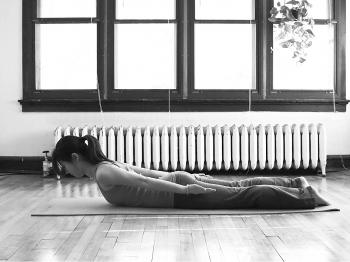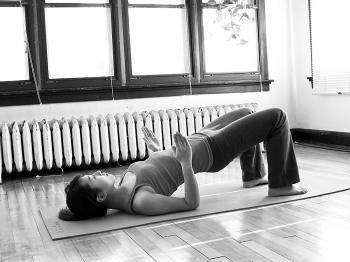Looking confident and taller are two bonuses that come with good posture. In addition to the aesthetic benefits, proper posture allows for the least amount of strain on our bodies’ muscles and ligaments as we sit, stand, and walk each day. Proper alignment of bones and joints also helps decrease backaches, muscle pains, and excess wear and tear on joint surfaces that could contribute to arthritis.
Unfortunately, proper posture may be the last thing on our minds as we put in those extra hours in front of the computer, leaving us with slumped shoulders and rounded backs. Becoming more acutely aware of optimal spine alignment by training the abdominal and back muscles will help us regain better posture.
Pilates and yoga are great exercise methods for strengthening abdominal muscles like the transverse abdominis, and internal and external oblique’s. These muscles often help improve our posture by correcting skeletomuscular imbalance. Swimming and rowing are exercises that can strengthen the muscles running along your spine. A combination of specific weight lifting exercises such as rows and chest stretches can support better alignment by unleashing tightness in the chest while strengthening the upper back muscles.
However, access to fitness classes, the pool, or weights may not be available or convenient for everyone. Try these three simple moves you can do at home within a few minutes to obtain better spine alignment and improved posture.
Unfortunately, proper posture may be the last thing on our minds as we put in those extra hours in front of the computer, leaving us with slumped shoulders and rounded backs. Becoming more acutely aware of optimal spine alignment by training the abdominal and back muscles will help us regain better posture.
Pilates and yoga are great exercise methods for strengthening abdominal muscles like the transverse abdominis, and internal and external oblique’s. These muscles often help improve our posture by correcting skeletomuscular imbalance. Swimming and rowing are exercises that can strengthen the muscles running along your spine. A combination of specific weight lifting exercises such as rows and chest stretches can support better alignment by unleashing tightness in the chest while strengthening the upper back muscles.
However, access to fitness classes, the pool, or weights may not be available or convenient for everyone. Try these three simple moves you can do at home within a few minutes to obtain better spine alignment and improved posture.
Prone Mountain Pose
Prone mountain is a popular yoga pose used for building better alignment for optimal posture. While performing this movement, imagine that your body is elongating from head to toes.
To begin, lie face down on a mat with arms close to your ribs and palms facing up. Firmly plant the tops of your feet into the ground while lifting the nose a few inches off the floor. Energize the arms and reach the fingertips toward the knees. Try to keep the chest as firm against the floor as possible and maintain shoulders in neutral position—when the shoulders are rounded or pulled back to the spine, the optimal posture is compromised. Also take care to avoid scrunching the neck back ward or letting the belly droop down.
Hold the pose for 45 seconds and slowly build up to 60 seconds with daily practice. To conclude the pose, relax the arms and slowly lower the nose to the ground.
Supine Bridge Pose
The supine bridge pose is used in both yoga and rehabilitation to help stabilize the spine and alleviate misaligned pelvic positions. This pose requires engagement from both abdominal and back muscles to get into position and maintain it.
To start, lie on your back. Bend the knees so that the feet are six inches away from the buttocks and shoulder width apart. Keep the toes pointed forward and legs parallel and neck elongated. Place the arms by your ribs, bending the elbows and face the palms inward. Engage the abdominal muscles. Inhale, and on the next exhale, slowly lift the hips off the floor till the hip join is fully extended. Maintain a neutral spine and avoid over arching the back.
Hold the pose for 45 seconds and slowly build up to 60 seconds with daily practice. To move out of the pose, slowly lower the vertebrate one at a time as the hips move back toward the floor.
Single Leg Lift on Exercise Ball
This is a simple exercise that can be done on an exercise ball to build core stability and strength that will ultimately compliment proper alignment and posture. If you have no access to an exercise ball, a chair will serve the purpose.
Sit on the exercise ball with knees shoulder width apart, feet pointed forwarded, and knees bent at a 90-degree angle. Activate core muscles to stay upright and maintain stability on the ball. Contract the hip flexors and slowly lift one leg up to 6 inches off the floor and hold for 30 seconds. Repeat on the other side. Perform two sets.
Beginners can perform this exercise close to a wall and place one hand on the wall to help with stability. If performing this exercise on a chair, try lifting both legs off the floor simultaneously for an extra challenge.










